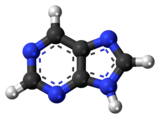Traube purine synthesis
 |
|
 |
|
 |
|
| Names | |
|---|---|
|
IUPAC name
9H-purine
|
|
| Identifiers | |
|
3D model (Jmol)
|
|
| ChEBI | |
| ChemSpider | |
| ECHA InfoCard | 100.004.020 |
| KEGG | |
| MeSH | Purine |
|
PubChem CID
|
|
|
|
|
|
| Properties | |
| C5H4N4 | |
| Molar mass | 120.12 g·mol−1 |
| Melting point | 214 °C (417 °F; 487 K) |
|
Except where otherwise noted, data are given for materials in their standard state (at 25 °C [77 °F], 100 kPa).
|
|
|
|
|
| Infobox references | |
A purine is a heterocyclic aromatic organic compound that consists of a pyrimidine ring fused to an imidazole ring. Purine gives its name to the wider class of molecules, purines, which include substituted purines and their tautomers, are the most widely occurring nitrogen-containing heterocycle in nature.
Purines are found in high concentration in meat and meat products, especially internal organs such as liver and kidney. In general, plant-based diets are low in purines. Examples of high-purine sources include: sweetbreads, anchovies, sardines, liver, beef kidneys, brains, meat extracts (e.g., Oxo, Bovril), herring, mackerel, scallops, game meats, beer (from the yeast) and gravy.
A moderate amount of purine is also contained in beef, pork, poultry, fish and seafood, asparagus, cauliflower, spinach, mushrooms, green peas, lentils, dried peas, beans, oatmeal, wheat bran, wheat germ, and haws.
...
Wikipedia
